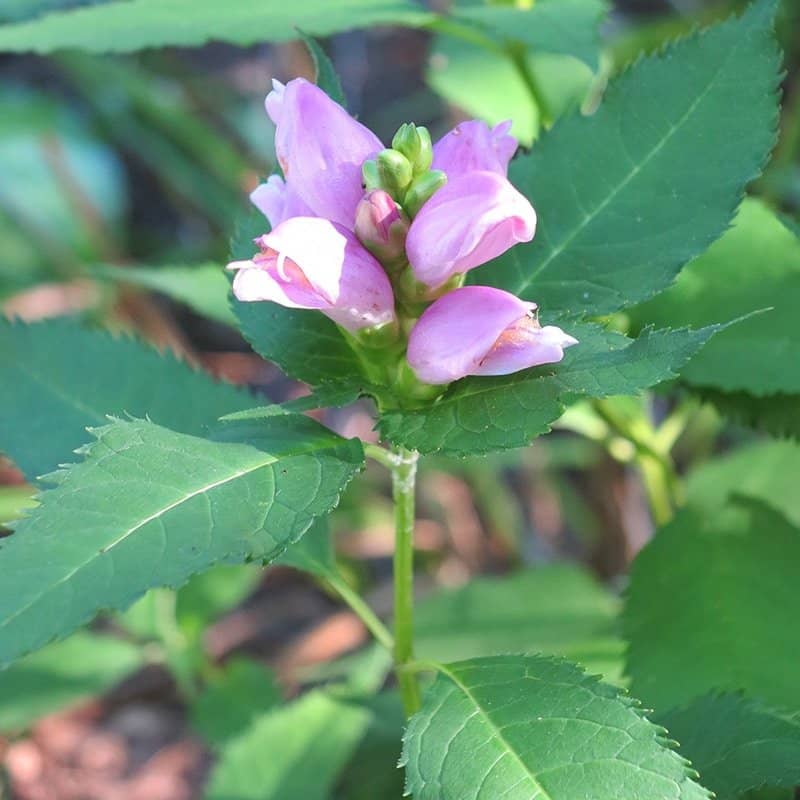
In mid-August, I visited the perennial gardens at the Stratford Festival in Ontario to see what was in bloom. Predictably, there were several large clumps of phlox, but I was surprised to find tall thick stands of culver’s root (Veronicastrum virginicum, 4 x 3 feet / 1.2 m x 60 cm) and turtlehead (Chelone obliqua, 3 x 2 feet / 90 x 60 cm), two old-fashioned Zone 5 plants that bloom in late summer through early fall and not often seen in garden borders.
Tall culver’s root is closely related to ordinary plantain weed, and carries similar vertical flower spikes of closely spaced florets. (Although I don’t suppose many gardeners look that closely at the plantain flowers now blooming enthusiastically in driveway cracks.) Sometimes named cultivars are available, such as bright mauve ‘Lilac Karina’ and light pink ‘Erica’, but the white species (V. v. f. album) is just as beautiful. Culver’s root makes a generous, bushy plant that’s attractive to bees and butterflies, and produces enough flowers to cut blooms for vases. Perennial plant author Allan Armitage likes to include them in vases with yarrows and statice, and his bouquet is a good illustration of three plants that can be used to fill gaps in late-summer gardens.
Full sun and plenty of moisture keeps culver’s root standing tall and producing masses of flowers. The stems generally don’t need staking, but pounding rain or strong wind can put them on a bit of a slant. I sometimes slip in four to six thin bamboo stakes at the edges and run a piece of green garden twine around the clumps. The stakes are hardly noticeable when set close to the stems.
Turtlehead is another late-summer plant for sunny, moist locations and makes a good companion to culver’s root. Sometimes turtlehead is sold as a shade plant, and it will certainly bloom in light shade, but the best display by far is in full sun. Turtlehead makes thick clumps similar in girth to culver’s root, but the flower stems are slightly shorter. There is a bright pink species (C. obliqua rosea) as well as the white species, and there are also named cultivars, such as ‘Pink Sensation’ and C. lyonii ‘Hot Lips’, both lighter pink than the species. For my money, I prefer the darker pink species plant. Turtlehead has self-supporting, upright stems with shiny green foliage at the bottom and hooded flowers at top. (The flowers remind me of monkshood, another fall-blooming plant.)
The upright flower stems and vertical profile of culver’s root and turtlehead make them good candidates for filling in gaps between shrubs and among earlier blooming perennials. Both make generous clumps, but their upright form won’t spread out and overlap with neighbours. Where space permits, set three clumps together for more impact. These old-fashioned standbys remind me of my grandmother’s garden, and still provide useful vertical accents to beds and borders in the lull between midsummer and fall displays.

I have Turtlehead + Culver’s Root and they both do fabulously in Zone 4 (possibly 3, there is some debate over this), in my garden 1 1/2 hours north of Montreal. And my pink Turtlehead absolutely glows in the shade, the pink stands out better than on my clump in the sun.
Also, pollinating insects love the Culver’s Root.
Recently at a garden lecture I heard that Veronicastrum sibiricum blooms earlier and longer, and is more sturdy than V. virginicum. Although I try to use native plants as much as possible, I am going to try the sibiricum, because my gardening season is so short, this far north.
I love your columns, keep up the good work!
I have a big clump of turtehead and I find it quite invasive. It will choke out the roots of other plants as well. It is a beautiful plant and I love that it flowers at this time of year when most plants are long past their prime.
I envy you your turtlehead! I am assuming you have a clay-based soil that keeps them particularly happy moisture-wise. I am in Nova Scotia in a very fast-draining soil area that even with amendments cannot seem to keep this plant happy enough to bloom let alone thrive like yours. Just goes to show that rule of “the right plant for the right place” is true!